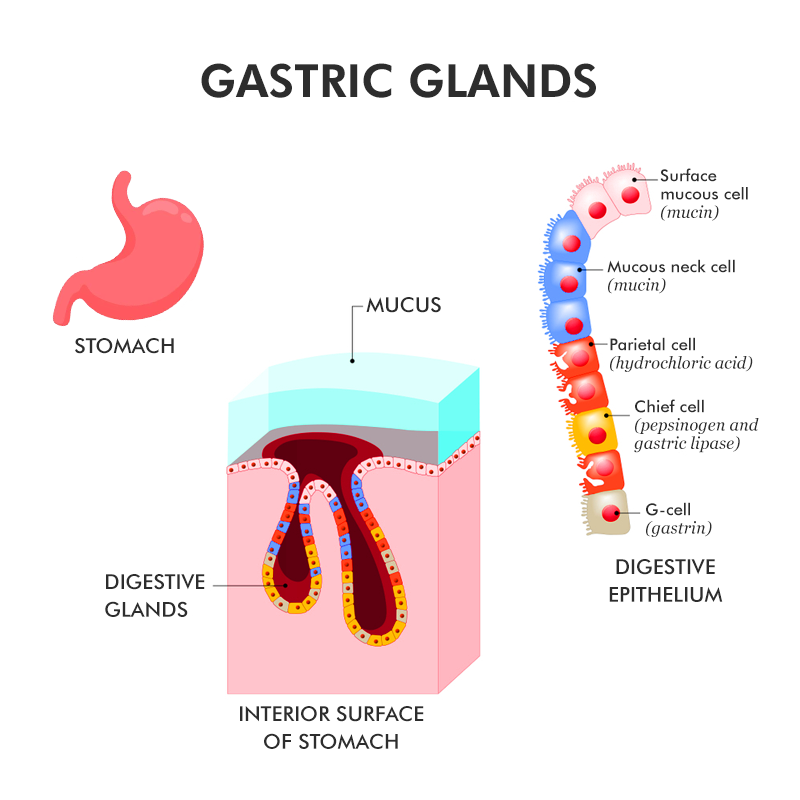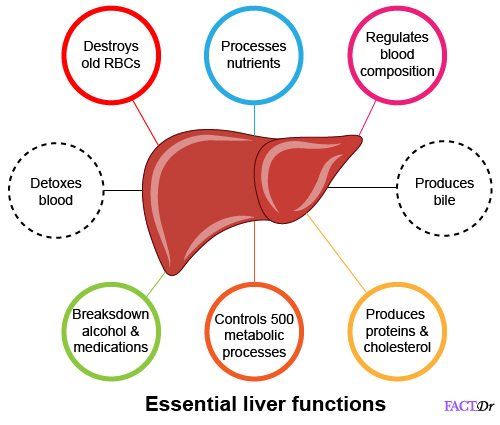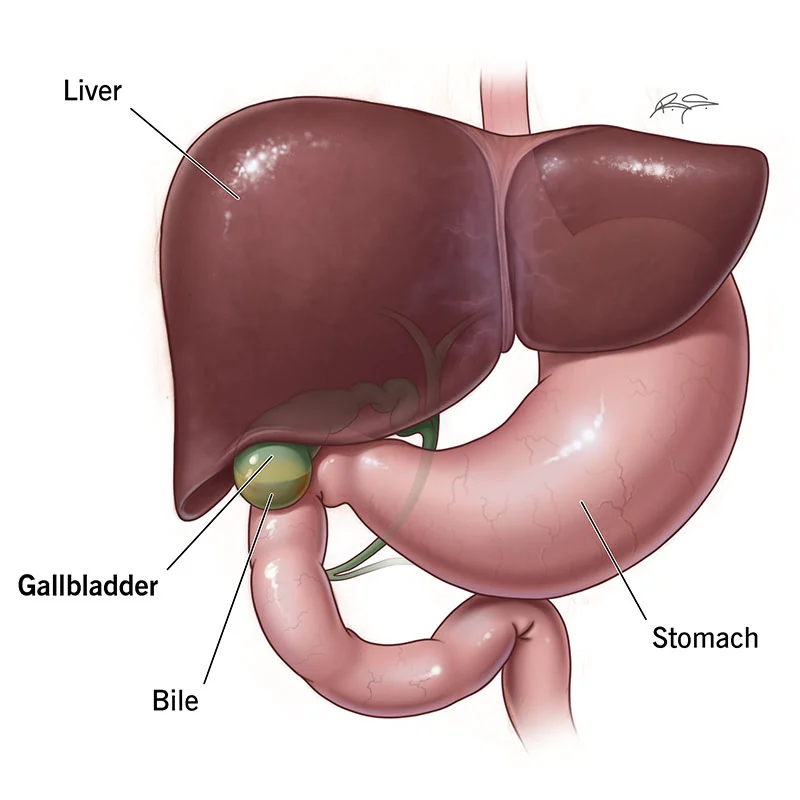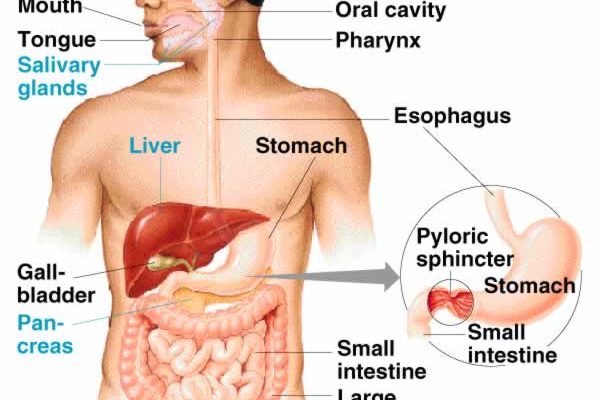Table of Contents
Digestive Glands
Digestive glands are a group of glands in the digestive system that produce and secrete substances necessary for digestion and absorption of nutrients from food. These glands secrete digestive enzymes, acids and other substances that break down food into smaller molecules that can be absorbed by the body.
5 Types of Digestive Glands
5 types of glands associated with the Alimentary Canal serve the process of digestion of food. They are as follows
- Salivary Glands
- Gastric Glands in the Stomach Lining
- The Liver and the Gallbladder
- Pancreas
- The Intestinal Glands
Salivary Glands
The Salivary Glands are the first digestive glands to come into contact with the food we eat. They secrete saliva, a fluid that moistens the food and contains an enzyme called salivary amylase, which breaks down complex carbohydrates into simpler sugars.

3 types of Salivary Glands
There are three types of Salivary Glands-
- Parotid Glands- they are located just in front of and below each ear.
- Submandibular Glands- They are located on the inside of the lower jaw on each side.
- Sublingual Glands- They are located below the tongue.
Each gland has excretory ducts that transport the secreted saliva into the mouth. Small amounts of saliva are constantly secreted, with the flow of saliva increasing considerably when eating.
Saliva is a slightly acidic (pH 6.8) fluid containing water (about 99%), salts, mucus and an enzyme called salivary amylase (also called ptyalin).
Also Check – What is the role of Saliva in the Digestion of Food?
Functions of Salivary Glands
The Salivary Glands have several functions, including-
- Moistening food to make it easier to swallow
- Breaking down complex carbohydrates into simpler sugars through the action of salivary amylase
- Moistening the mouth and oral cavity
- Supports oral hygiene by flushing away food particles and debris
- Provides some protection against harmful microorganisms
Also Check – 9 Important Functions of Salivary Glands
Gastric Glands in the Stomach Lining
The Gastric Glands are located in the Stomach lining and secrete gastric juice containing hydrochloric acid, pepsin and mucus.

Functions of The Gastric Glands
The functions of the Gastric Glands include
- Killing bacteria ingested with food- The hydrochloric acid secreted by the Gastric Glands kills bacteria ingested with food.
- Facilitating the action of the pepsin enzymes on the proteins contained in the food- The acidic pH of the gastric juice facilitates the action of the pepsin enzymes on the proteins contained in the food.
- Preparation of the ingested food for further processing in the small intestine- The partially digested food in the Stomach is called chyme, which is gradually released into the small intestine for further processing.
- Protection of the gastric mucosa from the action of hydrochloric acid produced under normal conditions- The mucus secreted by the Gastric Glands protects the lining of the Stomach from the action of hydrochloric acid produced under normal conditions.
Also Check – What will happen if Mucus is not Secreted by the Gastric Glands?
Liver
- The Liver is the largest gland in the body.
- It secretes bile, which helps to excrete and metabolise fats.
- The Liver produces bile, which acts on large fat molecules to form smaller globules.
- The Gallbladder stores the bile and releases it into the small intestine when needed.
- The Liver increases the efficiency of enzyme action, i.e. emulsification.
- The Liver converts excess glucose into glycogen, which can later be converted into glucose for energy.
- The Liver breaks down drugs and other toxic substances.

Functions of the Liver
Production of bile-
- Bile is produced in the Liver and stored in the Gallbladder.
- Bile helps digest and absorb fats by emulsifying large fat molecules into smaller molecules that can be easily digested by enzymes.
- Bile also helps in the elimination of waste products such as bilirubin and cholesterol.
Metabolic functions-
- The Liver plays a key role in the metabolism of carbohydrates, proteins and fats.
- It stores glucose in the form of glycogen and releases it when needed to maintain blood glucose levels.
- The Liver also synthesises proteins and produces enzymes necessary for digestion.
Detoxification-
- The Liver is responsible for eliminating drugs, alcohol and other toxins from the body.
- To do this, it breaks down these substances into less harmful compounds that can be eliminated from the body through the urine or faeces.
- The Liver also helps philtre waste products and old red blood cells from the blood.
Storage-
- The Liver stores various vitamins and minerals, such as iron and vitamin A.
- It also stores excess glucose in the form of glycogen for later use.
- The Liver is responsible for the production and regulation of cholesterol and triglycerides.
Also Check – 15 IMPORTANT FUNCTIONS OF THE Liver
Gallbladder
The Gallbladder is a small organ located below the Liver that stores bile and releases it into the small intestine when needed.

Functions of Gallbladder
- Concentration of bile- The Gallbladder stores and concentrates bile so that it is stronger and more effective in digesting fats.
- Release of bile- When fatty foods enter the small intestine, the Gallbladder contracts and releases bile through the bile duct into the small intestine, where it helps digest fats.
The Pancreas-
The Pancreas is an organ located behind the Stomach and connected to the small intestine by its main duct, the pancreatic duct. It is both an endocrine and an exocrine gland.

Functions of the Pancreas
- Production of enzymes- the Pancreas produces pancreatic juice which contains digestive enzymes such as amylase, protease, trypsin and lipase. These enzymes help break down carbohydrates, proteins and fats in the small intestine so that they can be absorbed into the bloodstream.
- Regulation of blood sugar levels- The Pancreas plays a crucial role in regulating blood sugar levels. It produces the hormones insulin and glucagon, which together control blood sugar levels in the body. Insulin helps to lower blood sugar levels, while glucagon helps to raise them.
- Stimulating Stomach acid- The Pancreas also produces a hormone called gastrin, which stimulates the Stomach to produce acid. This acid helps break down food in the Stomach before it passes into the small intestine for further digestion.
9 Important Function of Pancreas Class 10
The Intestinal Glands
The walls of the small intestine contain numerous glands that secrete intestinal juice.

Function of Intestinal Glands
- Intestinal juice contains amylolytic, proteolytic and lipolytic enzymes that help digest carbohydrates, proteins and fats.
- The amylolytic enzymes in the intestinal juice break down complex carbohydrates into simpler sugars that can be absorbed by the body.
- Proteolytic enzymes help digest proteins by breaking them down into amino acids that the body can use to build and repair tissues.
- Lipolytic enzymes help break down fats into smaller components, such as fatty acids and glycerol, which can be absorbed by the body.
Also Check -How is the Small Intestine designed to absorb Digested Food ?
Also Check- What is the role of Digestive Enzymes ?
Frequently Asked Questions About Digestive Glands
What are Digestive Glands?
Answer- Digestive Glands are a group of glands in the digestive system that produce and secrete substances necessary for digestion and absorption of nutrients from food. These glands secrete digestive enzymes, acids and other substances that break down food into smaller molecules that can be absorbed by the body.
How many types of Digestive Glands are there?
Answer- There are 5 types of Digestive Glands, including the Salivary Glands, the Gastric Glands in the Stomach lining, the Liver and Gallbladder, the Pancreas and the Intestinal Glands.
What is the function of the Salivary Glands?
Answer- The Salivary Glands moisten food to make it easier to swallow, break down complex carbohydrates into simpler sugars through the action of salivary amylase, moisten the mouth and oral cavity, aid oral hygiene by washing away food particles and debris, and provide some protection against harmful microorganisms.
What are the three types of Salivary Glands?
Answer- The three types of Salivary Glands are the parotid glands, submandibular glands and the sublingual glands.
What is the function of the Gastric Glands in the Stomach lining?
Answer- The Gastric Glands secrete gastric juice, which contains hydrochloric acid, pepsin and mucus. The functions of the Gastric Glands include killing the bacteria ingested with food, facilitating the action of pepsin enzymes on the proteins contained in food, preparing the ingested food for further processing in the small intestine and protecting the gastric mucosa from the action of hydrochloric acid produced under normal conditions.
What is the function of the Liver?
Answer- The Liver secretes bile that aids in the elimination and metabolism of fats, produces bile that acts on large fat molecules to form smaller globules, increases the efficiency of enzyme action (i.e. emulsification), converts excess glucose to glycogen that can later be converted to glucose for energy, and breaks down drugs and other toxic substances.
What are the functions of the pancreatic gland?
Answer- The functions of the Pancreas include the production of enzymes that help digest carbohydrates, proteins and fats, regulate blood sugar levels and appetite, and stimulate Stomach acid.
What is the function of the Intestinal Glands?
Answer- The Intestinal Glands secrete intestinal juices that contain amylolytic, proteolytic and lipolytic enzymes that aid in the digestion of carbohydrates, proteins and fats.
What is bile and what is its function in the body?
Answer- Bile is a digestive fluid produced by the Liver and stored in the Gallbladder. Its main function is to emulsify fats so that they can be digested more easily by enzymes. It also helps to eliminate waste products such as bilirubin and cholesterol.
What are the metabolic functions of the Liver?
Answer- The Liver plays a key role in the metabolism of carbohydrates, proteins and fats. It stores glucose in the form of glycogen and releases it when needed to maintain blood glucose levels. The Liver also synthesises proteins and produces the enzymes needed for digestion.
What is the role of the Liver in detoxification?
Answer- The Liver is responsible for eliminating drugs, alcohol and other toxins from the body. It breaks down these substances into less harmful compounds that can be eliminated from the body in the urine or faeces. The Liver also helps filter waste products and old red blood cells from the blood.
What does the Gallbladder do?
Answer- The Gallbladder is a small organ located below the Liver. It stores bile and releases it into the small intestine when needed.
What is the function of the Pancreas?
Answer- The Pancreas is an organ located behind the Stomach and connected to the small intestine by its main duct, the pancreatic duct. It produces digestive enzymes and hormones, including insulin and glucagon, which regulate blood sugar levels.
What is the job of the Intestinal Glands?
Answer- The walls of the small intestine contain numerous glands that secrete intestinal juices containing amylolytic, proteolytic and lipolytic enzymes. These enzymes help digest carbohydrates, proteins and fats so that they can be absorbed by the body.


16 Comments on “Digestive Glands – Definition , Types and Functions”